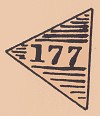
- SEARCH
-
Purchase CardCart
( 0 )
My Purchase Card
0 ITEMS IN YOUR BASKET

| Introduction | ||||
| PM 1 | PM 6 | PM 11 | PM 16 | PM 30 |
| PM 2 | PM 7 | PM 12 | PM 17 | PM 31 |
| PM 4 | PM 8 | PM 13 | PM 25-27 | PM 32-35 |
| PM B4 | PM 9 | PM 14 | PM 28 | PM 33 |
| PM 5 | PM 10 | PM 15 | PM 29 | PM Other |
Postmark Type 29
 Description - PM type 29 (JC-MN-RF) equilateral triangular design with variations within. This most encountered sub-types have either parallel lines of sporadic horizontal dashes (MN/RF type 29a), or with a slightly less encountered small dots (MN/RF type 29). An ill-defined two-lined inset with letter D above numerals below, mostly recorded with three digits. A few are found in blue ink, but far less than the 10% in number that Cooper states
Description - PM type 29 (JC-MN-RF) equilateral triangular design with variations within. This most encountered sub-types have either parallel lines of sporadic horizontal dashes (MN/RF type 29a), or with a slightly less encountered small dots (MN/RF type 29). An ill-defined two-lined inset with letter D above numerals below, mostly recorded with three digits. A few are found in blue ink, but far less than the 10% in number that Cooper statesOften the numerals on this PM are difficult to discern. Cooper notes observing about 50 numbers between 45-461 on singles. Martin (p.112) lists just 7 known numbered POs, dating between 1866-1871. However, it seems these are taken from Renouf’s revised work (1951), and refer only to identified instances. Renouf records dates from 1865-74. Only a few instances are found on cover or piece, with context sufficient to identify them. He also notes on singles (his PM 29) 3, 25, 45, 48, 57, 69, 128, 135, 142, 147, 168, 175, 218, 251, 272, 277, 284, 341, 348, and (his PM 29a) 150, 214, 312, 414, 454. Many others single examples are found in this collection.
Thought to be used in small remoter parts of the Madras postal sub-region, the seven identified POs lay in Tamil Nadu, Karnataka, Andhra Pradesh. This D letter type is thought to have been utilised long after the C series was first established, possibly about 10 years afterwards. One plausible theory was that it was a district post like PM. Considered scarce. Two blue instances D-67 singles are found in this collection. Extremely scarce.
Examples found in this collection are probably some of those actually recorded by either Renouf or Martin! The highest recorded number D-696 dated 29th July 1866, is the earliest included, while other instances are later than previously noted. A Bellary example (probably D-142) dates 20th May 1874, another with accompanying Talook Tapel Puducottah is dated 2nd January 1876, and yet another D-101 Guntoor 24th August 1878!
 PM subtype 29a - (JC) type 33 (RF) not quite an isosceles triangle with varying base line lengths. Within are various abbreviated letters such as Poona COL TE.
PM subtype 29a - (JC) type 33 (RF) not quite an isosceles triangle with varying base line lengths. Within are various abbreviated letters such as Poona COL TE. Very little is known about this subtype, and although theories have been proposed about these partial town name abbreviations within, no one yet understands their entire meaning. These are possibly rare rather than very scarce Cooper considered Very Scarce, although they might be rare.
 Only one example is present in this collection on cover dating to October 1868.
Only one example is present in this collection on cover dating to October 1868.  PM subtype 29b - (JC) type 40 (RF) an equilateral triangle with three corners containing small parallel lines, leaving well-defined numeral inset, without letter. All instances seen, or recorded, seem to have numeral 177. Renouf notes use on 1856-64 DLR issue. Possible very local use. Cooper mistakenly notes it Renouf type 31b.
PM subtype 29b - (JC) type 40 (RF) an equilateral triangle with three corners containing small parallel lines, leaving well-defined numeral inset, without letter. All instances seen, or recorded, seem to have numeral 177. Renouf notes use on 1856-64 DLR issue. Possible very local use. Cooper mistakenly notes it Renouf type 31b. Single stamp instance seen in collection, plus I have recently seen a few other single instances with the same PO number. Considered scarce, although possibly very scarce.
 PM subtype 29c-e – (JC) these three triangular subtypes, with place names at base, dates above, sometimes partitioned, one with S, others rarely found on actual stamps, but on covers – some seem sorting marks, or similar, more at home within the PM type 19 to 24 groups, especially JC TPO PM type 20e.
PM subtype 29c-e – (JC) these three triangular subtypes, with place names at base, dates above, sometimes partitioned, one with S, others rarely found on actual stamps, but on covers – some seem sorting marks, or similar, more at home within the PM type 19 to 24 groups, especially JC TPO PM type 20e.


Examples of sorting type 29e seen between 7th December 1866 to 13th June 1869





